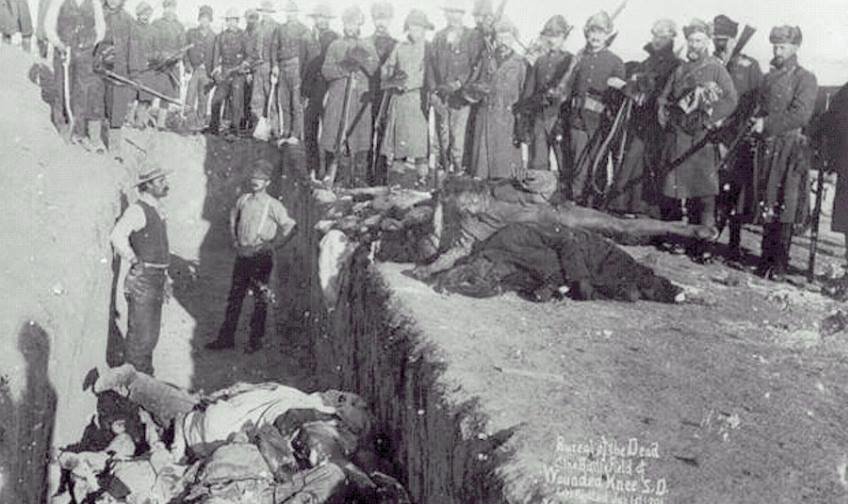The 1890 Wounded Knee Massacre isn't given much attention in history books, but it's an uglier part of our country's past that arguably contradicted the second amendment—giving citizens the rights to bear arms— violated human rights while designating 20 soldiers heroes by awarding them with the Army's Medal of Honor.
The massacre was the result of the U.S. government's desire to seize land and move indigenous people from their homelands. This bubbled to the surface in 1890 as Indians at the Lakota Pine Ridge Indian Reservation in South Dakota took part in the Ghost Dance Spiritual Movement—a practice to reject the ways of the white man with the belief that God would create the world anew.
On Dec. 29 the U.S. Army's 7th Cavalry surrounded a band of ghost dancers near Wounded Knee Creek and Col. James W. Forsyth demanded they surrender their weapons and told them they'd be relocated to another camp.
A fight between a soldier and a deaf Indian named Black Coyote resulted in a shot being fired—though it remains unclear who fired the weapon first. U.S. Soldiers began shooting at the unarmed group and managed to kill as many as 300 Indians—many of them women and children. The soldiers were aided by cannon rounds from Hotchkiss guns.
Prior to the attack, women and men had been separated. Despite this, the soldiers took no effort to spare their lives. As women began running, the soldiers hunted them down.
Eye-witness accounts were recorded in by the 1891 Commissioner of Indian Affairs and gave a chilling synopsis of the ways women and their children died at the hands of the soldiers:
"Right near the flag of truce a mother was shot down with her infant; the child not knowing that its mother was dead was still nursing, and that especially was a very sad sight. The women as they were fleeing with their babes were killed together, shot right through, and the women who were very heavy with child were also killed."The account continues on, stating that small boys who had emerged from hiding thinking it was safe were also butchered by soldiers.
A woman who survived lost her daughter and baby boy. According to her account, one shot passed through the baby's body and hit her elbow, causing him to drop to the ground. She was also hit twice in the back.
Several days later, government authorities dug a mass grave for 146 bodies of children, women and men. They stripped the bodies naked and piled them on top of each other in the frozen ground.
The U.S. Army suffered 25 causalities in the fight and 20 members were awarded the Army's Medal of Honor—it's highest commendation. More soldiers received the Medal of Honor in Wounded Knee than the 64,000 South Dakotans who fought for four years of World War II. According to author David Grua, the US government considered Wounded Knee the final chapter of a "race war" between whites and Native Americans.
In the years after 1890, the U.S. Army made Wounded Knee a central event in American public memory, awarding 20 Medals of Honor to the Seventh Cavalry and erecting a monument to the soldiers killed in the engagement. Wounded Knee was heralded as the final victory in the 400 year "race war" between civilization and savagery, the event that laid the foundation for the American nation's subsequent prosperity.
Native American activists have long called for the medals to be withdrawn and in 2001 the National Congress of American Indians passed two resolutions condemning the awards. Despite years of petitions, Congress has failed to rescind the medals. Today, the Lakota tribe continues to fight to have their perspective of events included in the US Government's "official memory" of the massacre, as well as seek reparations for the descendants of Wounded Knee victims.




Primitive- 1a, of or pertaining to an earliest or original stage. b. Archetypal.
2, characterised by simplicity or crudity; unsophisticated. 3, of pertaining to earlier stages in the evolution of human culture: primitive societies.
Sophisticate-1,to cause to become less natural or simple; especially to make less naive; make worldly wise. 2. To corrupt or pervert; adulterate; no longer pure. 3. To make more complex or inclusive. GREEK- sophistikos-from. -ed- having acquired worldly knowledge or refinement; lacking natural simplicity or naivite. -sophistry- a plausible but misleading or fallacious argument; faulty reasoning.